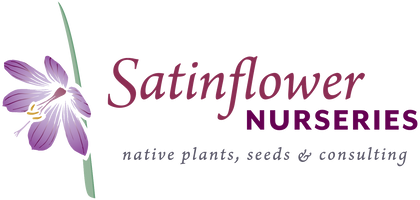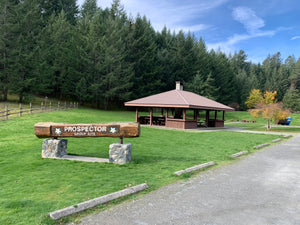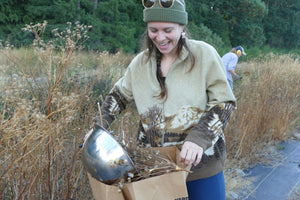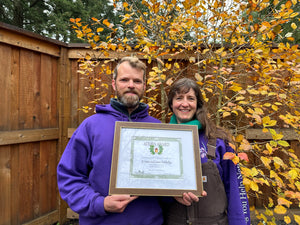Weekly with Daly: Nestbox Design & Maintenance

The Weekly with Daly is a regular column about the musings of the nursery written by our in-house wildlife observer and passionate conservationist, Julia Daly.
October 23, 2021
Most of us place nestboxes in our yards with the best of intentions: to support local birds and watch hungry nestlings grow. Often it is a project done with kids. After a few seasons, however, many nestboxes become derelict and forgotten about after being weathered by wind and rain or damaged by invasive Eastern grey squirrels. These non-native squirrels chew entrance holes larger to gain entry (Fig. 1). If you have a nestbox on your property, fall is a good time to see if any repairs are needed and to remove old nesting materials that may be harbouring harmful bacteria or parasites. This way, your nestbox will be in good condition for spring when birds begin looking for nesting sites again.
While most birds prefer natural nesting cavities, they are becoming harder to find. The removal of dead and decaying trees from the landscape, urban sprawl and the proliferation of invasive cavity-nesting birds like *house sparrows (Passer domesticus, Fig. 2) and European starlings (Sturnus vulgaris), have left native cavity-nesting species with fewer places to raise their young. Though nestboxes are not a replacement for quality habitat and protecting existing wildlife trees and native vegetation should take priority, nestboxes can provide a good alternative for some species.

Figure 1. Nestbox entrance has been chewed larger by a squirrel

Figure 2. Male house sparrow. Photo: Mathias Appel.
The bird species you are hoping to attract should influence what features to integrate into your nestbox’s design, like entrance hole size and nestbox height. Research your target species’ habitat preferences before placing the box. Consider the direction in which the box is facing to avoid long periods of direct sunlight or strong winds. Consider ways of limiting accessibility to predators like racoons and house cats (Fig. 3). A nest box is not a yard ornament; it should have a purposeful function. A poorly designed or maintained nestbox can do more harm than good.
*House sparrows and starlings, which were introduced to North America from Europe in the 1800s, aggressively compete with native species for nesting sites and will kill adult birds and their young (using their strong bills) to take over a cavity or nestbox. Because these resident birds secure nesting sites earlier than many of the migratory species in our region, consider blocking the entrance hole over the winter and do not remove until April, after most house sparrows and starlings have already secured nesting sites and native migratory species, like swallows, are just beginning to look. This tactic may be especially helpful if you are trying to attract larger species that require an entrance hole larger than 1 ⅛”.
Things to look for in a well-designed nest box:
- Constructed of natural untreated wood, with walls at least ¾ inch thick to provide insulation. Cedar is especially resistant to weathering.
- If in an urban area or farmland, the entrance hole diameter is small enough to exclude *house sparrows (1 ⅛”). An elliptical-shaped hole ⅞” in the middle tapering to ⅝” on either side can be used to allow entry by swallows but exclude house sparrows. Chickadees and house wrens can use 1 ⅛” holes.
- Constructed with galvanized nails or screws that will not rust.
- The entrance hole is fitted with a protector made of metal or another hard material to prevent damage by squirrels (Fig. 4).
- Extended and sloped roof to protect the interior from rain and direct sunlight.
- Adequate ventilation holes (in four corners of the floor and under the roof) to keep the interior dry and cool.
- NO outside perches, as they aid predators and harassment by house sparrows
- Swinging side panel or roof secured by latch or nail to allow for annual cleaning of the interior to remove soiled nesting materials (Fig. 5).

Figure 3 (left). Mounting nestbox on a metal post, rather than a fence or tree, can help deter climbing predators like cats and raccoons. Surrounding the post with a smooth PVC pipe or another predator guard can be even more effective.
Figure 4 (middle). A metal entrance hole protector prevents chewing by squirrels.
Figure 5 (right). A swinging door (that secures shut with latch or loosened nail) allows access to clean out old nesting materials. This should be done annually in the fall or early winter.
Being a nestbox steward is a commitment and takes good planning, but the effort can be rewarding. Finding a clean, well-tended nest during fall cleaning is a delight (Fig. 6). I have found that some bird parents are more diligent than others in removing their nestling’s ‘faecal sacs’ (look it up!) from the nest, even amongst individuals of the same species. Sometimes the nests I find are wretched, other times they are pure enough to add to a bird's nest collection that can be used to educate others. I find the differences in nesting materials used by various species fascinating.

Figure 6. A clean, well-tended nest is always a delight.
For more information on nestbox design and placement, check out this great resource provided by the Cornell Lab of Ornithology.
https://nestwatch.org/learn/all-about-birdhouses/
I hope you’ve enjoyed this Weekly with Daly.
Signing off,
Julia
- Julia Daly






